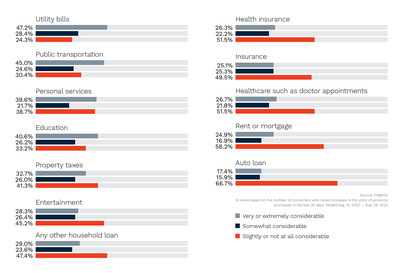Three in Five Americans Live Paycheck to Paycheck: More People Are Living Paycheck to Paycheck but Making Ends Meet Than Not Living Paycheck to Paycheck
Rhea-AI Summary
LendingClub Corporation (NYSE: LC) released findings from its Reality Check: Paycheck-To-Paycheck research series, revealing significant financial strains among U.S. consumers. As of August 2022, 60% are living paycheck to paycheck, a 3% increase from September 2021. Among high-income earners, 54% earning between $100,000 and $150,000 live paycheck to paycheck, highlighting the impact of inflation on spending. Notably, 92% of consumers have noticed price increases, with gas and groceries being the most affected. The report emphasizes changing consumer behaviors in response to rising costs.
Positive
- None.
Negative
- 60% of Americans are living paycheck to paycheck, indicating rising financial instability.
- 54% of high-income earners ($100,000-$150,000) live paycheck to paycheck, a 7% increase from July 2022.
- 92% of consumers report price increases in everyday purchases, affecting overall spending capacity.
News Market Reaction 1 Alert
On the day this news was published, LC gained 0.90%, reflecting a mild positive market reaction.
Data tracked by StockTitan Argus on the day of publication.
More Than Half of Americans Earning Between
SAN FRANCISCO, Sept. 27, 2022 /PRNewswire/ -- LendingClub Corporation (NYSE: LC), the parent company of LendingClub Bank, America's leading digital marketplace bank, today released findings from the 14th edition of the Reality Check: Paycheck-To-Paycheck research series, conducted in partnership with PYMNTS.com. With inflation reaching a 40-year high in June, nearly all consumers report noticeable increases in the cost of everyday purchases. The Inflation Edition examines the financial lifestyle of U.S. consumers who live paycheck to paycheck, explores how inflation impacts their spending and details saving decisions and how rising prices impact their financial lifestyle.
The research places paycheck-to-paycheck consumers into two categories: those who can pay their monthly bills without difficulty and those who struggle to do so. In August 2022,
"More consumers living paycheck to paycheck indicates that many are continuing to lose their financial stability," says Anuj Nayar, LendingClub's Financial Health Officer. "Yet, the share of consumers living paycheck to paycheck with issues paying their bills has dropped 7 percentage points in the past year. Many have moved to what now may constitute a stable lifestyle: living paycheck to paycheck but still managing to pay your monthly bills. There is just nothing left over at the end."
In August 2022, three in five U.S. consumers were living paycheck to paycheck, and close to one-fifth struggled to pay their bills. The share of consumers living paycheck to paycheck has trended upward over time, increasing from
Consumers in the lowest range of the upper income brackets are particularly likely to be sliding toward paycheck-to-paycheck life:
With inflation reaching a 40-year high in June, nearly all consumers cited noticeable increases in the cost of everyday purchases. Fuel and groceries were cited most for considerable price increases.
Gas prices explain most of the Consumer Price Index (CPI) increases, and consumers felt the impact across multiple categories, including utilities and groceries. The report finds that
Similar shares of paycheck-to-paycheck consumers reported higher prices in both products and services, yet those with issues paying their monthly bills were more likely to notice. PYMNTS' data finds that
PYMNTS' data also finds that financial lifestyle can determine what paycheck-to-paycheck consumers consider "essential". While responses from consumers of all financial lifestyles indicated that groceries were "essential", there were notable differences for other expenses. For example, paycheck-to-paycheck consumers with issues paying their monthly bills were less likely to purchase fuel for a car or pay their utility bill than paycheck-to-paycheck consumers without difficulty paying their monthly bills and consumers that do not live paycheck to paycheck.
PYMNTS' research finds that
Consequently, most consumers report changes in their shopping preferences and less spending capacity. The reduction in purchasing power is changing consumers' purchasing behaviors in everything from merchant choice to transportation habits. One-quarter of consumers who changed how they manage and spend money due to inflation report that this has forced them to be more money-smart, while
When consumers choose to spend, they are utilizing credit products like credit cards to fund their lives and most have not noticed changes to the interest rates of credit products, even though they are increasingly using credit while tightening budgets. For example, nearly a quarter of paycheck-to-paycheck consumers are unaware of the rates they pay for financing.
"It is no secret that prices have been increasing for everyday Americans – not only in the goods and services they purchase but also in the interest rates they're paying to fund their lives," continued Nayar. "While Americans are modifying their spending in light of inflation, there is still a disconnect with many not yet seeing the true cost of credit products. This can have detrimental consequences for someone who pays the minimum amount on their credit cards every month. Advising consumers to simply cut back on spending to stay on budget and only spend on 'essentials' is no longer helpful financial advice. 'Essential' means something different for everyone."
Inflation has an equal impact on rural and urban consumers, with nearly all consumers citing noticeable increases in their everyday expenses. Fuel and groceries were cited most for having sizable product price increases, with rural consumers more likely to report increases than urban dwellers.
Although generally similar shares of rural and urban consumers report higher prices in both products and services, rural consumers are slightly more likely to do so. While
More than one-third of rural consumers have significantly changed how they manage and spend their money, while just one-quarter of urban consumers have done so. Urban consumers are more likely to limit their spending and shift their shopping preferences than rural consumers, however.
Regardless of where they live, consumers are well aware that living costs — especially fuel, groceries, and utilities — have been on the rise, making it increasingly difficult to make ends meet. Consequently, consumers of all income brackets are adjusting how they manage their spending, with many prioritizing their "essential" products.
To view the full report, visit: https://www.pymnts.com/study/reality-check-paycheck-to-paycheck-inflation-consumer-spend-expenses/
New Reality Check: The Paycheck-To-Paycheck Report: The Inflation Edition is based on a census-balanced survey of 3,495 U.S. consumers conducted from August 10 to August 29, 2022. The Paycheck-To-Paycheck series expands on existing data published by government agencies such as the Federal Reserve System and the Bureau of Labor Statistics to provide a deep look into the elements that lie at the backbone of the American consumer's financial wellness: income, savings, debt and spending choices. Our sample was balanced to match the U.S. adult population in a set of key demographic variables:
LendingClub Corporation (NYSE: LC) is the parent company of LendingClub Bank, National Association, Member FDIC. LendingClub Bank is the leading digital marketplace bank in the U.S., where members can access a broad range of financial products and services designed to help them pay less when borrowing and earn more when saving. Based on more than 150 billion cells of data and over
CONTACT:
For Investors: IR@lendingclub.com
Media Contact: Press@lendingclub.com
PYMNTS Contact: information@PYMNTS.com
![]() View original content to download multimedia:https://www.prnewswire.com/news-releases/three-in-five-americans-live-paycheck-to-paycheck-more-people-are-living-paycheck-to-paycheck-but-making-ends-meet-than-not-living-paycheck-to-paycheck-301633823.html
View original content to download multimedia:https://www.prnewswire.com/news-releases/three-in-five-americans-live-paycheck-to-paycheck-more-people-are-living-paycheck-to-paycheck-but-making-ends-meet-than-not-living-paycheck-to-paycheck-301633823.html
SOURCE LendingClub Corporation








